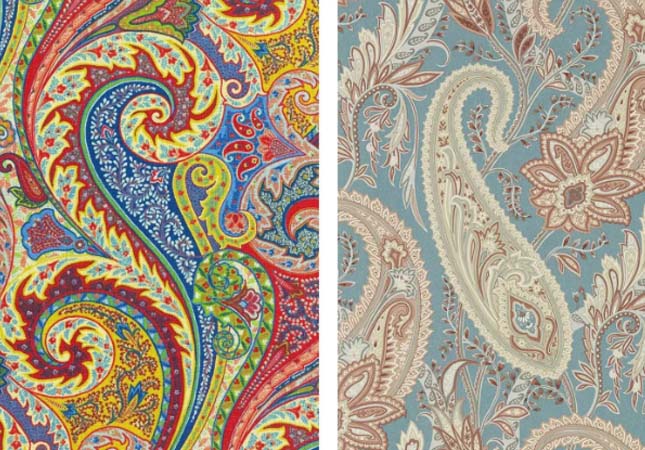The Paisley pattern originated in Babylon and spread to Persia and India afterwards through Kashmir where is an important station on the ancient Silk Road route. It is a highly adaptable ethnic pattern and was originally woven on wool fabrics in dark colors by a series of textile machines such as textile cutting machine, weaving loom and jacquard loom machine etc. Paisley pattern resembles water droplets, pine cones, leaves and apricots, has different names and derived shapes in various countries, for example the name “ham pattern” in China and the “jade pattern” or “curved jade pattern” in Japan.

The Spread of Paisley Pattern
The paisley pattern spread to India and was enthusiastically sought after by the royal aristocrats during the Mughal period (AD 1526-1764). Almost everything from stone carvings to royal decorations are in paisley patterns.
In the 18th century, the French King Napoleon brought Kashmir shawls back to France as trophies during the colonial war, then the paisley-style shawls exported from India began to be popular in Europe. By the 19th century, the increasing demand for textiles with this pattern in western countries made the India original fabrics could not meet the market, so that a town in England named Paisley began to imitate the production of shawls and other fabrics in this kind of pattern and named this pattern after the town’s name.
The profound influence of primitive Indian religion and culture on the Bangladeshi nation makes the two ethnic groups with similar appearance even have similar folk customs. Also, makes the paisley pattern gradually developed and become popular in Bangladesh. The Bengal nation is good at weaving exquisite handmade fabrics, which further improved the paisley pattern textiles in Bangladesh more delicate, complex and gorgeous than those produced in India.
Significance & Evolution of Paisley Pattern
The paisley pattern resembles the "tree of life" in Hinduism (Bodhi leaves or date palm leaves), but many researchers believe that its appearance is similar to mangoes, cut figs, pine cones or paramecia. It evolved from the miniature of plants and flowers, then now look like a "huge comma" after hundreds of years of continuous evolution.
The Mughal Empire ruled Bangladesh from the 17th century to the 18th century AD, so the ethnic areas of Bangladesh were dominated by Islamic civilization and were influenced by Islamic decorative styles. The Paisley patterns were characterized by abstraction and non-spirituality, and were express by using flowers and geometric figures at that time, which is relatively general and abstract. The belt used by the nobles (males) of the Bengal court during the Mughal period was designed in above patterns. While in the 18th century, the paisley pattern was introduced to France and was influenced by the Baroque and Rococo styles that were popular in Europe at that period, the combination of the complicated decoration symbolizing romanticism and the traditional form began. Due to the decorative nature of the paisley pattern, the Kashmiri people use it on textiles, such as shawls. Then, with the change of the times and teh aesthetics, the Indian and Bengali peoples used it in daily clothing and necessities, such as traditional saris.
Other Representative Bangladeshi Handmade Patterns
Bangladeshi representative handmade fabrics can be divided into 3 categories: geometric patterns, plant patterns and animal patterns.
1. Geometric Patterns
Geometric patterns are the most commonly used in handmade fabrics, generally are composed of triangles, rectangles, and circles to form symmetrical and continuous patterns, such as symmetrical patterns, polka spots, and rectangles. The Jadani sari is often patterned in 2 continuous designs.
2. Plants Patterns
Plant patterns are usually drawn from regional characteristic plants or plant patterns of religious beliefs, almost are patterned in simple curves of flowers, vines and grasses that are highly decorative and symbolic.
3. Animals Patterns
Animal patterns are different from plant patterns in the specific symbolism and representation, mostly are drawn from peacock elements, symbolizing wealth and luxury.
Bangladeshi traditional handmade fabrics have rich artistic and cultural heritage, and their inheritance and development reflect the contemporary nature of the combination of Bangladeshi folk arts and handicrafts.




